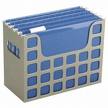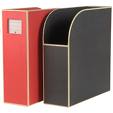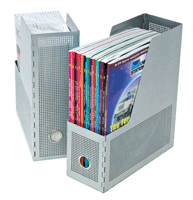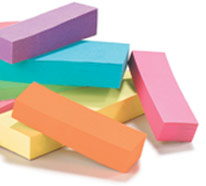Put Manuals on Automatic–Organizing Owner’s Manuals (Part 1-Paper)
Did you accidentally change the default language on your Caller-ID box, and now your messages are listed in Spanish? Get the manual!
- Do you have so much trouble with pictograms that you can’t laundry labels, let alone your new digital camera’s icons? Find the manual!
(Seriously, are we really supposed to know the difference between ![]() (Machine Wash Warm) and
(Machine Wash Warm) and ![]() (Machine Wash Hot, Gentle Cycle) from just looking at the icons? No wonder there are whole web pages created to explain digital camera icons like
(Machine Wash Hot, Gentle Cycle) from just looking at the icons? No wonder there are whole web pages created to explain digital camera icons like ![]() and
and ![]() , which Paper Doll thinks should mean “Oooh, Pretty” and “Zip up your zipper”, respectively. But I digress.)
, which Paper Doll thinks should mean “Oooh, Pretty” and “Zip up your zipper”, respectively. But I digress.)
- When Daylight Savings Time passes into (or out of) vogue in your zip code, do you struggle with resetting the time on your computer, your car’s clock, or your TV, VCR or DVR? Grab the manual!
(FYI, if your DVR clock is set by your cable company, good luck. Paper Doll‘s sister’s cable company changed her time zone setting and is unable or unwilling to set it back, no matter how many imploring calls she makes. It’s as if her televisions have been relocated to a time zone of their own. Indeed, it might be easier for her to just move to Iowa and be done with it!)
Tinkering types who refuse to seek directions, aside, we’ll all need an owner’s manual or user’s manual at some point. In most houses, those manuals tend to get piled up in a kitchen drawer or at the bottom of a magazine rack, making it hard to find the exact one you need, and making it more likely you’ll hold onto a manual long after you have discarded the item it explains. In fact, as a professional organizer, I often encounter manuals for phones, electronics and household gadgets that the clients have long-since lost, sent off to college with their children or otherwise tossed away.
Without a system for managing your manuals, you’ll end up with clutter…you’ll keep things you don’t need and will be unable to put your hands on what you’re seeking. Maintaining your hard-copy owner’s manuals can be really simple, however, if you create a home where manuals live. Just follow these steps:
Gather all the owner’s manuals, user’s manuals and instructions you can find. Make a stack (or multiple stacks) and corral them in a central location so you can quickly review each one.
Eliminate the manuals for items you really know how to use. While you may, someday, want or need to know how the microwave manufacturer advises poaching eggs, it’s highly likely that if you’re savvy enough to use a computer to read blogs, there are no secrets for you to glean from the manuals for your toaster or hair dryer. Flip though each manual–if there’s nothing in it that isn’t dictated by common sense…send it to the recycling bin.
Eliminate the manuals written in languages you don’t speak. It’s become very common for manufacturers to send out packaging with bilingual instructions. Unless you are intending to resell or auction an item of high value in a locale where English is not the primary language (and the non-English manual is in the prospective buyer group’s primary language)…let it go! If you can’t bear to toss these manuals, check with the language department at a local middle or high school to see if they might use the foreign-language manuals for class projects.
Keep “like with like”, so that you not only have the manual, but the unpacking display (also know as “What’s In The Box?”), schematics (in case it’s hard to tell which way is up), the replacement parts re-ordering guide and anything that isn’t merely advertising.
Sort the manuals into categories, such as:
- Major household appliances (water heater, refrigerator, washer/dryer, electric garage door)
- Kitchen appliances (food processor, bread maker, microwave)
- Home theater electronics (televisions, stereos, DVRs)
- Computer hardware and software (including peripherals like printers and scanners)
- Communication devices (phones, smart/cell phones, pagers, walkie-talkies)
- Personal electronics (MP3 players, book readers, pedometers, heart rate monitors)
- Specialty manuals (exercise equipment, home medical equipment)
Create an easily-accessed home for the manuals by selecting options according to your style preference:
1) Maintain a sub-section of the Household division of your Family Files, specifically for manuals.

If you have multiple thin manuals in a category, one manila folder per category should suffice. Larger manuals will be more suitable with one to a folder, with one folder per product/item.
*Note 1a: Using the family file system works great for almost all household and personal appliances. However, it’s usually best if computer hardware and software manuals are kept close to your your computer/modem/wireless router/printer/scanner set-up. If your family files are kept in the same general area of your computer (such as in a home office), you’re all set. If not, option #2 might work better for computer/software manuals.
*Note 1b: Keep your auto owner’s manual in your glove compartment. While it’s a minor inconvenience to have to go to your upstairs office to find the fridge manual if the ice maker stops working, it would at least a major inconvenience–possibly even a road hazard–to have to wait until you get home (if you got home) to decipher your dashboard’s emergency lights.
2) Store manuals in magazine files.
 (Heals.co.UK)
(Heals.co.UK)  OnlineOrganizing.com
OnlineOrganizing.com
This grants slightly easier, quicker access than having to let your fingers do the walking through your vertical hanging folders. If you miss the sub-labeling that a file system provides, you can label manila folder tabs and divide the categories–like individual software types (productivity, games, drivers, etc.). However, this will slightly diminish available space, and you will only be able to use left-side tabs, as middle and right will fall inside the magazine file and will not be visible for reading.
Alternatively, you can divide manual categories by labeling and affixing wide tape flags to the left binding of each manual, which will allow you to color-code and even alternate the space so all labels can be viewed at a glance.
wide tape flags to the left binding of each manual, which will allow you to color-code and even alternate the space so all labels can be viewed at a glance.
3) Maintain manuals in three-ring binders. 
Paper Doll has recommended three-ring binders and plastic sheet protectors as the solution for organizing papers as varied as recipes, maps and school documents. It can be a great solution for most owner’s manuals and instructions, as it allows each manual to be preserved, clean and separate, and the individual plastic sheet protectors can be easily divided by categories using standard index tabs (or the aforementioned tape flags).
Binders do need to be sturdy, and shelf space must be maintained (as with the magazine files in option #2), but the biggest problem is that it’s particularly hard to store thick, book-sized manuals (such as you’ll find for computer hardware/software) in a three-ring binder. If this is an option that appeals to you, consider having at least one magazine file (or adequate bookshelf space next to the binders) to suit storing large manuals.
All of the above solutions keep your manuals vertical, standing at attention like little soldiers, at the ready to do battle against inexplicably blinking lights, stalled motors or flashing messages. But they also require maintaining a library of hard-copy paper manuals. If you’d prefer to skip the paper altogether (or if you already lost the instruction manual before you had a chance to test out your new gadget or appliance), there are myriad digital alternatives to maintaining a system of paper manuals.
Next week, we’ll to explore not only some of the most complete options for finding a digital version of manuals online, but we’ll also discuss how to organize the information for quick and easy digital retrieval (including how to figure out what’s wrong with your computer when your computer (or internet access) is failing you).




Follow Me